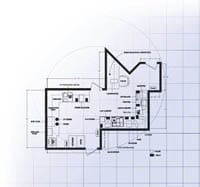|
EYE
ON EQUIPMENT Redesigning the Lab. By Liz Mart�nez DeFranco, A.B.O.C., N.C.L.C.
When dispensers give their office areas a facelift, they often consider redesigning the laboratory at the same time. Once contractors are scheduled to upgrade on the space, it's sensible to have them tackle the back when they come to work on the front. Doing the entire office at the same time means being inconvenienced only once. Costs can be lowered, too, when paying for a one-time appearance by tradespeople rather than having them make two separate visits. But before picking up the Yellow Pages, there are a few details regarding lab improvements that must be ironed out. Rushing into a lab redesign can cause more turmoil than expected. Fortunately, experts say that with the proper advance planning, eyecare professionals can enjoy a lab upgrade with a minimum of fuss and a maximum of pleasure. Most equipment manufacturers have experience installing hundreds of labs, and they're willing to share their expertise with their customers. They are often glad to provide layout drawings for the new room specifications, and to tip you off about the required plumbing and electrical specs. To help you avoid the most common errors, here the experts talk about mistakes many people make and what to do about them. NOT ENOUGH JUICE PROBLEM: The new edger requires more electrical power than expected. SOLUTION: Most people who do a lab improvement job on their own don't provide for enough power. Household or typical office electricity is 15-amp, but edgers need a 20-amp circuit that's dedicated-meaning that the edger is the only equipment hooked up to that circuit. It gets expensive to add electrical lines afterwards, so plan ahead. -Stuart Watson, National Optronics
MAINTAINING POWER PROBLEM: Our computerized equipment is not functioning well in the upgraded lab. SOLUTION: You don't want to have a lot of surges or drops in power when you have computerized equipment in the lab. These power changes can damage the machines. If you're installing new equipment, ensure that you have enough electrical outlets and amperage, as well as enough circuit breakers to handle the load. If you make sure that the electricity is correct in the first place, you won't have problems later. -Tracey Morrison, Optical Works Corp. EQUIPMENT DIMENSIONS PROBLEM: The new lab doesn't accommodate the new equipment. SOLUTION: You don't want to build the lab before selecting your equipment because machines vary in width, depth, and height. Choose the equipment that you want before building cabinets or laying out other machinery. If you make your choices ahead of time, you will be able to have shelves built at the correct height and cabinets made to fit job trays above the equipment. Knowing what you are going to put in beforehand also allows you to set up a good work flow in the lab. -Matt Vulich, AIT HOLE IN THE WALL PROBLEM: The do-it-yourself redesign of the lab didn't turn out so well. SOLUTION: Sometimes when people decide to remodel the lab, they don't -Linda Little, vice president, WECO International SENSITIVE EQUIPMENT PROBLEM: Some equipment is being affected negatively by the machines that are nearby.
SOLUTION: It's important to plot out equipment placement before you install it in order to maintain job flow. Design your flow in a straight line or a U shape, depending on the space available in the lab. Sensitive equipment should be placed next to each other, and never next to or across an aisle from a machine that creates a lot of dust. You don't want to put a dye tank or a tracer near a cylinder machine or a high-production edger, for example. -Michael Urban, Gerber Coburn DOWN THE DRAIN PROBLEM: The existing sink isn't compatible with the new edger. SOLUTION: Just because you have a sink doesn't mean that you can run an edger. Especially in older buildings, the water pipes might not be big enough to accommodate an edger, or there may not be an on-off water valve switch underneath the sink. This valve is similar to house faucets on the side of a house. In the lab, they're used to turn the water off if the edger isn't being used. If the pipes or the sink were installed a long time ago, they may not have been done by an authorized plumber. Often, dispensers don't know these details. All they know is that the sink works, and that might not be enough to run an edger. A plumbing professional needs to determine what additional work must be done to accommodate an edger. -Nancy Safran, director of marketing, Briot VENTING IS GOOD FOR YOU PROBLEM: The fumes from the tint unit are penetrating the office area. SOLUTION: Some people forget about the tint unit when they're redesigning their labs. The problem is that the tint unit emits an odor, which can leak out into the dispensary. To prevent this from happening, it's necessary to have exhaust ventilation, similar to the vent that is placed over a kitchen stove. A contractor needs to install it so that it vents the fumes outside, and patients and personnel don't inhale them. If you don't put in an exhaust vent when you're redesigning the rest of the lab, you wind up spending money after the lab is finished, and it doesn't look as good. -Clark Smith, regional training manager, Santinelli International EB Got a question you'd like answered in a future "Eye on Equipment" column? Send it now!
|
Article
Redesigning the Lab
Eyecare Business
May 1, 2000





